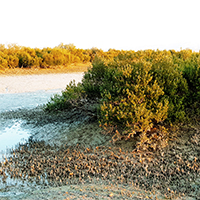Isolation and identification of halophilic and halotolerant bacteria from the sediments of the Qeshm Island mangrove forest
Phylogeny of bacterial community of mangrove forest sediments

Submitted: 8 December 2019
Accepted: 16 March 2020
Published: 12 May 2020
Accepted: 16 March 2020
Abstract Views: 4165
PDF: 1242
HTML: 423
HTML: 423
Publisher's note
All claims expressed in this article are solely those of the authors and do not necessarily represent those of their affiliated organizations, or those of the publisher, the editors and the reviewers. Any product that may be evaluated in this article or claim that may be made by its manufacturer is not guaranteed or endorsed by the publisher.
All claims expressed in this article are solely those of the authors and do not necessarily represent those of their affiliated organizations, or those of the publisher, the editors and the reviewers. Any product that may be evaluated in this article or claim that may be made by its manufacturer is not guaranteed or endorsed by the publisher.


 https://doi.org/10.4081/aiol.2020.8743
https://doi.org/10.4081/aiol.2020.8743



